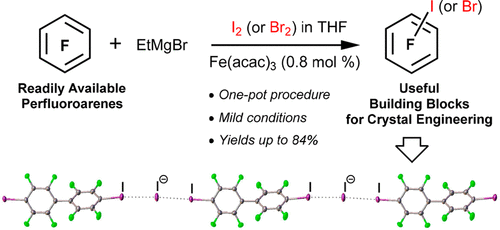当前位置:
X-MOL 学术
›
Cryst. Growth Des.
›
论文详情
Our official English website, www.x-mol.net, welcomes your
feedback! (Note: you will need to create a separate account there.)
One-Pot Route to X-perfluoroarenes (X = Br, I) Based on FeIII-Assisted C–F Functionalization and Utilization of These Arenes as Building Blocks for Crystal Engineering Involving Halogen Bonding
Crystal Growth & Design ( IF 3.2 ) Pub Date : 2020-06-18 , DOI: 10.1021/acs.cgd.0c00606 Anton V. Rozhkov 1 , Anastasiya A. Eliseeva 1 , Sergey V. Baykov 1 , Bartomeu Galmés 2 , Antonio Frontera 2 , Vadim Yu. Kukushkin 1, 3
Crystal Growth & Design ( IF 3.2 ) Pub Date : 2020-06-18 , DOI: 10.1021/acs.cgd.0c00606 Anton V. Rozhkov 1 , Anastasiya A. Eliseeva 1 , Sergey V. Baykov 1 , Bartomeu Galmés 2 , Antonio Frontera 2 , Vadim Yu. Kukushkin 1, 3
Affiliation

|
Perfluorinated arenes (benzeneF derivatives, diphenylF, naphthaleneF) were converted into X-perfluoroarenes (X = Br, I) via the developed one-pot protocol based on [Fe(acetylacetonate)3]-assisted C–F functionalization. The syntheses proceed under mild conditions and employ readily available perfluorinated arenes, which are treated with EtMgBr followed by addition of X2/[Fe(acetylacetonate)3] (0.8 mol %); yields range from good to moderate. The σ-hole donor properties of the obtained mono- and di-X-perfluoroarenes and the significance of these species for halogen-bonding-based crystal engineering was illustrated in a series of postsynthetic experiments, all supported by density functional theory (DFT) energy calculations, molecular electrostatic potential (MEP) surface analysis, and the quantum theory of atoms in molecules (QTAIM). These include (i) a solid-state X-ray diffraction study of X-perfluoroarene self-association (dimerization) via iodine σ-hole—electron belt interactions (three X-ray structures) and (ii) verification of X-perfluoroarene σ-hole donor abilities by their interactions with iodides acting as external σ-hole acceptors (five X-ray structures); a Hirshfeld surface analysis was performed for all eight structures.
中文翻译:

基于Fe III的X-全氟芳烃(X = Br,I)的一锅法-辅助C–F功能化和利用这些芳烃作为涉及卤素键合的晶体工程的基础
全氟芳烃(苯F衍生物,二苯基F,萘F)通过基于[Fe(乙酰丙酮酸)3 ]辅助的C-F功能化开发的一锅操作规程被转换为X-全氟芳烃(X = Br,I)。合成在温和的条件下进行,并使用易于获得的全氟化芳烃,将其用EtMgBr处理,然后添加X 2 / [Fe(乙酰丙酮)3](0.8 mol%); 产量从良好到中等。一系列后合成实验证明了所得单-和双-X-全氟芳烃的σ-孔给体性质,以及这些物质对于基于卤素键的晶体工程的重要性,所有这些都得到密度泛函理论(DFT)能量的支持计算,分子静电势(MEP)表面分析和分子中原子的量子理论(QTAIM)。其中包括(i)通过碘σ-空穴-电子带相互作用(三个X射线结构)进行X-全氟芳烃自缔合(二聚)的固态X射线衍射研究,以及(ii)X-全氟芳烃σ的验证通过与充当外部σ空穴受体的碘化物的相互作用(五个X射线结构)实现空穴供体的能力;对所有八个结构进行了Hirshfeld表面分析。
更新日期:2020-06-18
中文翻译:

基于Fe III的X-全氟芳烃(X = Br,I)的一锅法-辅助C–F功能化和利用这些芳烃作为涉及卤素键合的晶体工程的基础
全氟芳烃(苯F衍生物,二苯基F,萘F)通过基于[Fe(乙酰丙酮酸)3 ]辅助的C-F功能化开发的一锅操作规程被转换为X-全氟芳烃(X = Br,I)。合成在温和的条件下进行,并使用易于获得的全氟化芳烃,将其用EtMgBr处理,然后添加X 2 / [Fe(乙酰丙酮)3](0.8 mol%); 产量从良好到中等。一系列后合成实验证明了所得单-和双-X-全氟芳烃的σ-孔给体性质,以及这些物质对于基于卤素键的晶体工程的重要性,所有这些都得到密度泛函理论(DFT)能量的支持计算,分子静电势(MEP)表面分析和分子中原子的量子理论(QTAIM)。其中包括(i)通过碘σ-空穴-电子带相互作用(三个X射线结构)进行X-全氟芳烃自缔合(二聚)的固态X射线衍射研究,以及(ii)X-全氟芳烃σ的验证通过与充当外部σ空穴受体的碘化物的相互作用(五个X射线结构)实现空穴供体的能力;对所有八个结构进行了Hirshfeld表面分析。











































 京公网安备 11010802027423号
京公网安备 11010802027423号